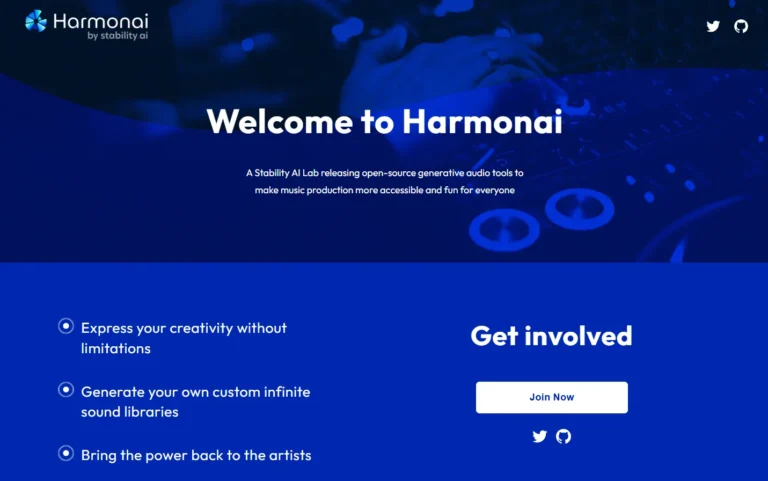Freemium
Open-source tool for creating unique musical sounds and samples.
Rating:
Discount: currently unavailable

Key Information
Features
- Advanced AI sound generation from white noise
- Real-time audio processing up to 95 seconds
- Style transfer for audio modification
- Text-to-audio generation with CLIP encoding
- Duration control with timing embeddings
- Open-source code base
- Cross-platform compatibility
- Community model library access
- Custom model training options
- Web-based sample explorer
Pros
- Revolutionary music generation through AI algorithms
- Community-driven continuous development
- Resource-efficient sound production
- Cross-platform accessibility
- Rapid audio prototyping capabilities
Cons
- Modern GPU hardware requirements
- Time-consuming learning curve
- Unpredictable AI generation results
Pricing
Free open-source platform with all features included. Voluntary donations accepted to support development.
---
What is Harmonai?
Harmonai brings AI-powered music creation to everyone through open-source generative audio tools. This innovative platform makes music production more accessible by letting users create unique sound libraries and explore new sonic possibilities.
The technology converts basic noise into high-quality audio samples, opening up fresh creative paths for musicians, producers, and sound designers. With its focus on community-driven development, Harmonai puts creative power back in artists' hands, letting them generate and customize their own infinite sound collections without traditional limitations.
Key Features
- Advanced AI Sound Generation powers the creation of unique 1-3 second audio samples from scratch. The platform uses diffusion technology to transform random white noise into high-fidelity sounds based on specific inputs, giving musicians endless possibilities for original content.
- Real-time Audio Processing enables quick generation of high-quality stereo audio. The system can produce up to 95 seconds of audio in under one second using modern GPU technology, making it highly efficient for rapid prototyping and experimentation.
- Style Transfer Capabilities allow users to modify existing audio files by adding controlled amounts of noise through the AI model. This feature helps create variations of original sounds and explore different artistic directions while maintaining musical coherence.
- Text-to-Audio Generation incorporates CLIP-like text encoding to understand relationships between words and sounds. Users can describe the type of sound they want, and the system generates matching audio samples.
- Flexible Duration Control includes timing embeddings that represent start times and total length of desired outputs. This gives users precise control over the length of generated audio pieces.
- Open-source Architecture encourages community participation and improvement. The platform's code is freely available, allowing developers and musicians to customize tools and contribute to the project's growth.
- Cross-platform Support ensures accessibility across web browsers, Windows, macOS, and Linux systems. This wide compatibility makes the tool available to creators regardless of their preferred operating system.
- Community Model Library provides access to various pre-trained models representing different sounds and aesthetics. Users can choose from multiple models trained on diverse datasets to find the perfect sound for their projects.
- Custom Model Training capabilities let users fine-tune models with their own datasets. This personalization feature helps create unique sound signatures and specialized audio generators.
- Web-based Sample Explorer called "This Sound Does Not Exist" offers a simple interface to discover and download unique AI-generated samples. This makes experimenting with new sounds quick and straightforward.
Main Advantages
- Revolutionary AI Music Generation transforms the way music is created by offering infinite possibilities for sound creation. The platform's advanced algorithms enable users to generate unique audio samples, melodies, and harmonies without traditional musical training.
- Community-Driven Development strengthens the platform through continuous improvements and updates from developers worldwide. This collaborative approach ensures the tools stay current with emerging music production trends.
- Resource-Efficient Production cuts down the need for expensive sound libraries and studio equipment. Musicians can create custom sound collections instantly using AI-powered generation tools.
- Cross-Platform Compatibility ensures seamless access across different operating systems and devices. This flexibility allows creators to work on their projects anywhere, anytime.
- Rapid Prototyping Capabilities speed up the creative process by generating multiple variations of sounds quickly. Musicians can explore different ideas and directions in minutes rather than hours.
Key Limitations
- Hardware Requirements demand modern GPUs for optimal performance when generating complex audio samples.
- Learning Curve requires time to master the AI parameters and understand how to achieve desired sound outputs.
- Limited Control over specific musical elements compared to traditional composition methods, as the AI generation process can be somewhat unpredictable.
How much does Harmonai cost?
Harmonai is completely free to use as an open-source platform. Users can access all core features, including AI sound generation, audio manipulation tools, and the community model library without any charges.
The platform operates on a donation-based model, allowing users to contribute voluntarily to support ongoing development.
Note: Prices are subject to change. Please check the official website for the most up-to-date prices.
Check Harmonai by Stability Official Pricing ›Frequently Asked Questions
1. What hardware requirements are needed to run Harmonai?
A modern computer with a GPU is recommended for optimal performance. While CPU-only operation is possible, it will be significantly slower. The system works best with NVIDIA GPUs that have at least 4GB of VRAM.
2. Who is using Harmonai?
- Music producers seeking fresh samples and sound design elements for their tracks
- Independent artists exploring new sonic territories without expensive equipment
- Sound designers creating unique effects for games and media projects
- Academic researchers studying AI-driven audio synthesis
- Music technology developers building upon open-source audio tools
- Electronic musicians looking for innovative sound creation methods
- DJs searching for unique samples to incorporate into their sets
- Experimental composers pushing musical boundaries
- Audio software developers integrating AI capabilities into their applications
- Music educators teaching modern production techniques
3. How does Harmonai compare to other AI music tools?
Unlike commercial alternatives like OpenAI's Jukebox or Google's Magenta, Harmonai focuses specifically on short-form audio generation and sample creation rather than full song composition. The open-source nature allows for community contributions and customizations not possible with closed systems.
4. What file formats does Harmonai support?
Harmonai works with WAV files for both input and output. Generated samples are exported as 44.1kHz stereo WAV files, ensuring compatibility with most digital audio workstations.
5. Can I use Harmonai-generated sounds commercially?
Sounds generated using the base models are released under Creative Commons Zero (CC0), meaning they can be used freely for any purpose, including commercial projects. However, when using custom-trained models, rights depend on the training data's licensing.
6. How can I contribute to Harmonai's development?
Developers can contribute through GitHub by submitting pull requests, reporting bugs, or improving documentation. Musicians can share trained models or contribute to the training dataset collection.
7. Is there a community platform for Harmonai users?
Users can connect through Discord channels and GitHub discussions to share experiences, showcase creations, and get technical support from other community members.
8. What makes Harmonai's diffusion model unique?
The platform uses a specialized audio diffusion model that gradually refines noise into coherent sound, allowing for more precise control over the generation process compared to traditional GANs or autoregressive models.
Advanced music generation platform for creating original audio and soundtracks.
Music generator creating original tracks for content creators and artists.
Music generation platform creating unique soundtracks for content creators.
Featured
Dynamic video creation from still images with smooth transitions and movements.
Comprehensive content blocker for safer, more focused digital experiences.
Online tool converting regular images into precise, scalable vector graphics.
Versatile writing assistant for content creation and document processing.
Professional product photography generator with customizable backgrounds.
Face-swapping platform for video content and marketing materials
Professional product photo generator for e-commerce sellers.
Smart study material generator for efficient exam preparation.
Personal English tutor offering natural conversation practice and instant feedback.
Video creation platform for social media content without filming.
Chat-based PDF research assistant for academic literature analysis.
Browser-based watermarking tool for protecting and branding photos instantly.
This tool offers a document assistant for efficient research and writing.
Digital advertising platform that automates creative content production.
AI-powered video, image & audio redaction software with advanced detection capabilities.
Full-stack application builder with deployment and testing capabilities.
Comprehensive academic companion for research-based document creation and editing.
Complete social media management platform for content creation and scheduling.



